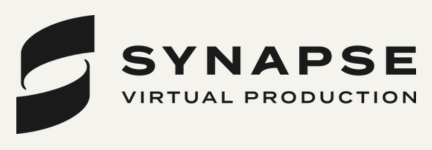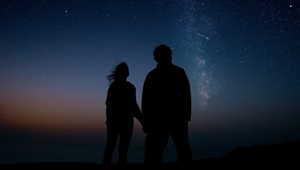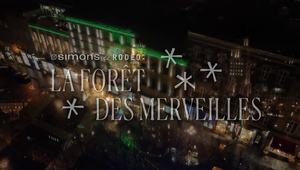
Rodeo FX and Stranger Things: A Relationship Crafted Across Dimensions

Seeing as February 14th is a day dedicated to celebrating romance, love and connection, it feels like the perfect time to talk about a very special relationship for ‘Stranger Things’. Without spoilers, it’s one that has been gradually building over a few seasons, as each side has figured out the other, and chemistry has grown. It’s a match made in heaven that any fan of the series could easily get behind. We’re of course talking about the show’s relationship with Canadian-based studio Rodeo FX – that’s what you were expecting, right?
The relationship between Rodeo and ‘Stranger Things’ is remarkable. From season three, the studio has worked its way up the totem pole, cementing itself as one of the show’s primary helpers for animation and VFX. Now even responsible for promotional ‘Stranger Things’ content – everything from live action experiences to Cannes-based pop-ups, and even a portion of the most recent 2025 teaser from Netflix – Rodeo has become the go-to for all things ‘Stranger Things’-related. This has filled the days of its team of artists for the past few years: from animating ‘demobats’, to figuring out ways to disintegrate some life-sized ‘demogorgons’. Like any relationship, the work has been challenging, but immeasurably enjoyable and gratifying.
LBB’s Jordan Won Neufeldt sat down with Rodeo FX animation supervisor Scott Holmes, VFX producer Antoine Sitruk, and VFX supervisor Julien Hery to discuss how each side fell for the other, and most importantly, kept the passion growing year after year, project after project. Follow us into the love story:
LBB> Tell us about Rodeo FX’s relationship with ‘Stranger Things’. How did you two first get together, and how has your relationship evolved since then?
Julien> We started with season three of ‘Stranger Things’. At the time, Martin Pelletier was the VFX supervisor, and we went on set where we got to know the Duffer Brothers better.
After season four, we were asked by the Netflix team to be in contact for all marketing work regarding the show. So, for everything ‘Upside Down’ related, we're the people now.
Antoine> Like Julien said, things have grown since we first started. We've become the studio that people come to for everything ‘Stranger Things’-related. And it's been a super good experience so far!
We spend a lot of time and effort on cool CG assets, which means it’d be a bit sad to just shelve them and not use them anymore. So, what’s really awesome is being asked to reuse them in many different scenarios – whether it’s for commercial work, immersive work, marketing stunts, etc. – meaning the products of our initial efforts get to live again.
LBB> Heading into the previous season, what was the briefing process like? Can you tell us more about those conversations?
Scott> Believe it or not, ‘Stranger Things’ was the first project I really got introduced to the team at Rodeo on. Obviously, I was familiar with the franchise – I'd loved it from the first season – so this was super exciting for me to roll out with.
What I quickly learned was everything had to be redone for season four, to make sure we were upholding the new standards of quality and photorealism. The ‘demodog’ was getting redone, the ‘demogorgon’ was getting redone, and then the ‘demobat’ was a brand new creature that we were going to get to animate. The conversations were pretty interesting. Usually they involved a bunch of '80s movie references, since everything kind of lives in that world. For example, with the demobat, the touchstone was the 'Alien' ‘Facehugger’ anatomy, and then we had to make it fly. Meanwhile, with the vines, the reference was 'Hellraiser', except it involved an extra step where we gave them a sneaky feeling and this sense of sentience. That’s kind of the aesthetic we have to adhere to – fresh and new, but consistently ‘80s.

LBB> Building on this, where did you begin with the animation process in season four? Walk us through the steps of what it took to bring the monsters to life!
Scott> The demodogs already had an established look, but we still went through the whole exercise of doing walk cycles, runs and attacks. But for the demogorgon, since season four is the first time we got to see its fury, we leaned into that. We did a bunch of attack tests, on the ground quadruped runs to stand up walking, and then we did the big key shot of the fight in prison. That helped us establish how it moves, how fast it is, and how violent it is.
One place where this really came through was in the prison attack sequence. We actually shot the plates with nothing on them – it was just people flying around on wires. And then it was up to us to come up with creative motion for the demogorgon. For that, we leaned into its slightly animalistic behaviours. Making it act a bit like a primate and allowing it to use its hands to move – not just his feet – was the big breakthrough for us. By moving away from the typical creature thing where you try to make them overly heavy, and instead leaning into its agility and the fact that it could move around on all fours, we found the right style for the job.
As for the vines, we did a lot of tests, and ended up with a serpentine kind of motion because it had the right feel for the show; it was eerie, ominous, and a distinct aesthetic. The hard part was getting ‘Vecna’ to hang from them and feel like they actually held his weight. But everything is done with tests on turntables, and we show those to the directors so they can tell very early on how a scene is coming along. If it’s slightly off, it gets called out and remedied.
LBB> Where did you begin with the VFX process for the recent Netflix teaser? How did you amalgamate years of work into such a short visual window?
Julien> When we received this opportunity, right away we got to work on our storyboard and dug into the memories of season four, trying to figure out which sequences we wanted to use as references. This was crucial, as the timeline was very different from what we’re used to. There’s more exploration when making a season. You have ideas, you try, you fail, and it’s OK. But when you make a commercial, it’s more like ‘the idea has been crafted, and we have to deliver right now’. We showed the directors (MEGAFORCE) what we’d come up with as quickly as possible. We needed them to know what the creatures and the vines could do. That way, they’d be able to plan and frame the shots.
As for your second question, it was all about the subtle details. Something like this is always about selecting the right references, and then targeting the small details to bring the sequence to life. A big one was the spores – something you always see floating in the Upside Down. But, when we bring back an asset from past seasons, we always try to amp it up a bit. So we did some work to ensure they matched modern day resolutions.
LBB> And what about ‘Stranger Things: The Experience’ – something you also played a critical role in. Did your VFX approach differ here, considering you were working with a different medium?
Antoine> This project was one of a kind for me, because I’d never done something to that scale in terms of immersive work. At Rodeo, we’re more used to the constraints of episodic or film content, so honestly, it was a big unknown at the time. The idea of creating media designed to play on a new, one-of-a-kind LED screen was always going to be a challenge.
Luckily, the main body of our work was creating the finale of the 45-minute experience, which allowed us to focus our efforts on this specific part, in front of this giant 3D screen. The 'highlight of the show' they called it. And that's where we started off from. The creatives at Netflix and MyCoToo had some storyboards, so we started to replace those with animatics. Then came a lot of creative brainstorming.
There were a few areas that took a lot of focus. The content was meant to be seen by guests with polarised glasses, so we had to render to each eye individually – a big technological challenge given the length of the finale. Then, there was the disintegration of the demogorgons. One would have been tricky (the animation of the demogorgon is complex), but we needed to vaporise an entire herd. A disintegration in the negative space, right in front of our guest, as well as the demand to keep it at 60 frames per second for quality of the immersion, and you’ve got a big challenge on your hands. And that was only one little bit! Overall, we had to stitch together 80,000 frames for 11 minutes of content (while hiding those stitches), and do a lot of travelling back and forth just to test it all out as the screen was only available at the actual experience. Quite a lot of work!

LBB> Across these three projects, was there a certain part of the process which you really loved?
Scott> I loved making the demobat. I have a fondness for that little creature, probably because it was the one I was the most involved in.
Here’s a fun fact: There's one frame in there where it looks just like the Facehugger (you probably can't see it), but I sculpted that on purpose, with a lot of love. Really, I just feel very close to that creature.
Antoine> For me, it was finally seeing our experience assets at full size. Keep in mind, we created everything for the small screen, so when we finally got to review our work on the 3D wall and meet our creatures – 9 feet tall and in super high resolution – it was amazing! It was just so cool seeing something like that at life-sized scale, especially because we’ve been working on the franchise for so many years.
I was also fond of how collaborative everything was during the immersive experience. The creatives of the projects were very inclusive and open to ideas, and for the entire shoot leading up to the experience, we were there every step of the way to guide them with our VFX and ‘Stranger Things’ knowledge. That was special, especially because we've been working on the franchise for so long!
Julien> To echo Antoine’s point, for me, the collaboration really felt special. In particular, working with MEGAFORCE was awesome because we listened to each other. We'd pitch an idea, and then they'd come back with, 'oh, yeah, that's great, but what if we do that on top?', and vice versa. That's how you do the best work possible.


LBB> Speaking of collaboration, projects like these aren’t doable without strong relationships with your fellow ‘Stranger Things’ crewmembers. Can you tell us more about how you work together to create a better end product?
Antoine> Consistent back and forth helps. With the Duffer Brothers, they know what they want, and are respected by everyone involved. We've been learning from them since season three, and have really gotten to know how they work. We've been saving everything we've learned over the years, and now whenever a new project comes up, we try to make sure that all this knowledge which has been acquired over the years is reused and improved. That also makes it easier to work hard – knowing it helps to nail down the final vision much quicker.
Scott> Everyone on that crew is very close, but I work particularly tightly with the modeling suit, riggers, and the lighting team. And then my partnership with Julien is especially important, since we'll talk about performance. If I have trouble with a sequence, we'll bat around a whole bunch of ideas and settle on the best one. The way I like to participate is that the best idea wins, so I don't really care who comes up with it. I like to check my ego at the door and become part of the team.
Julien> Working with the animation team is interesting to me because they speak their own little language. It really is a unique part of industry, and I like working with them. What I’ve learned is that often, it’s about creating a sandbox for ideas to thrive. They know the limitations, what they can do better, and they’ll challenge your ideas. So it’s important to listen to them.
LBB> Equally so, great artistic craft requires love and passion to be at its best. With that in mind, how have you injected these sentiments into your own work?
Scott> You have to look at the demogorgon fight sequence. If you go frame by frame, you’ll notice a lot of details. The way the arms and fingers drag, when he runs and slams a guy into the wall, etc. As animators, we watch every single frame to make sure it comes through. It needs to be interesting, hectic, entertaining, but above all else, fun to watch.
Antoine> I read an amazing book at the beginning of my producing career called ‘Creativity, Inc.’. And the thing that stuck with me, and which I still abide by today, is that producing creativity, contrary to goods production, needs room for mistakes.
In many ways, embracing this is an act of love for the work. In the process of creating, it’s OK to try something new, even if it doesn’t pan out, because that’s how you push a project to its maximum potential. Yes, a producer is the protector of budget, but when you have somebody breathing down your neck, creativity can struggle. That’s why you must remember that it’s OK to ask for space to try something better (which is usually easier if you bring it up early). Yes, it takes strong communication, but the work can often be better for it.
Julien> To me, it's not so much about how you make it – it's about the team you're working with. That's what drives me, and inspires me to craft with passion. The final picture is very important, but even more so are all the humans who are working with you. It's all about the collaboration, and that sense of love always carries over into what I make.

LBB> Finally, looking back, what part of this relationship with ‘Stranger Things’ have you loved the most?
Julien> What I love about ‘Stranger Things’ is the world itself. It's nice to be able to play with creatures and make them do lots of different things. They can jump, slash – it's very different from shot to shot. We always know everything we do is going to be scrutinised by the audience, so not only does it mean we can slip in Easter eggs, but it adds a healthy pressure that keeps us motivated to deliver.
Really, this show is so different from anything I've done before. When I was in Paris, I did 10 years of commercials, so getting to do something more crafty has been super rewarding. The level of VFX here is something I've only done with feature films before. I think that's amazing!
Antoine> To give a politician's answer, for me, it's been about the journey, rather than any one specific moment. Getting to fully see the evolution of our efforts and work.
The asks have only gotten bigger since we started. We’ve gone from iconic creatures like the demogorgon to designing Vecna, the main villain. We've changed the graphics to comply with the technology of the modern day. We’ve created Vecna’s ‘Mind Lair’, and all the details in there. We’ve created commercials and experiences. Just seeing the intricacy and knowing where we started and how we've gotten to where we are today – I think that's remarkable.
Scott> I love working with the crew. Everyone on the team is amazing – they really know the show and the passion they feel for it is just infectious. You wouldn't think you'd become close over a slasher series, but we did.
Seriously, I've been doing this for almost 25 years, and this show is probably one of the all-time highlights. So, I'm very grateful to Rodeo for giving me the opportunity to work on this.















